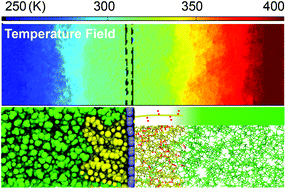Hierarchically hydrogen-bonded graphene/polymer interfaces with drastically enhanced interfacial thermal conductance†
Abstract
Interfacial thermal transport is a critical physical process determining the performance of many material systems with small-scale features. Recently, self-assembled monolayers and polymer brushes have been widely used to engineer material interfaces presenting unprecedented properties. Here, we demonstrate that poly(vinyl alcohol) (PVA) monolayers with hierarchically arranged hydrogen bonds drastically enhance interfacial thermal conductance by a factor of 6.22 across the interface between graphene and poly(methyl methacrylate) (PMMA). The enhancement is tunable by varying the number of grafted chains and the density of hydrogen bonds in the unique hierarchical hydrogen bond network. The extraordinary enhancement results from a synergy of hydrogen bonds and other structural and thermal factors including molecular morphology, chain orientation, interfacial vibrational coupling and heat exchange. Two types of hydrogen bonds, i.e. PVA–PMMA hydrogen bonds and PVA–PVA hydrogen bonds, are analyzed and their effects on various structural and thermal properties are systematically investigated. These results are expected to provide new physical insights for interface engineering to achieve tunable thermal management and energy efficiency in a wide variety of systems involving polymers and biomaterials.



 Please wait while we load your content...
Please wait while we load your content...
